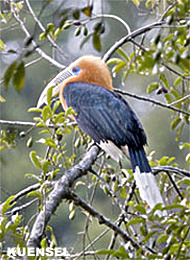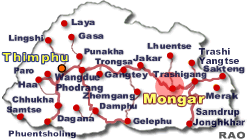| Bhutan's
Nature - Animals - Birds |
 |
Bhutan Nature Animals |
|
 |
BhutanInformation |
|
|
 |
| Bhutan - The last bastion of the hornbill |
 |
 |
| rufous-necked
hornbill
Bhutan's forests provide a safe haven for the rufous-necked hornbill, a bird that is classified vulnerable by the international union for conservation of nature (IUCN) and Birdlife international, according to a Thrumshingla national park official.
The hornbill, a big bird with an impressive curved bill and block-like casque on top of the head and bill, is found in Bhutan, Myanmar, China, Thailand, Laos, Vietnam and northeast India.It has suffered a huge population decline, and is considered extinct in Nepal, said the official, Rinchen Drakpa, who carried out an ecological study of the bird in the park.
|
|
"Through field observation, the naïve idea is that birds are safe in Bhutan," said the researcher. Rufous-necked hornbill is listed in the schedule I of the forest and nature conservation act of 1995 and forest rule of 2006 as an endangered species.
Rinchen Drakpa said that that he initiated the study, funded by critical ecosystem partnership fund (CEPF) and WWF, to determine the bird's habitat, density, distribution and nesting."The number of hornbills all over the world is showing a declining trend," he told.Loss of habitat through rapidly expanding development activities, poaching and hunting is attributed to the decline."In Nepal, the bird was hunted for meat and its beak, which is used for rituals," said Rinchen Drakpa, adding that he had seen the beak being used for ritual in Bhutan too.
 |
The researcher said that no study was done to determine the bird's population, although we know that it is there.The research team spotted 48 sightings, given chances of repetition, in an area of 428 sq km in TNP.
The rufous-necked hornbill species is found in mature, dense, evergreen and broadleaved forest, mainly in the hills up to altitudes of 1,800 m.It searches for large trees in which to nest.
|
In Bhutan, apart from TNP, it is found in Gonphu, Buli and Tshaidang in Zhemgang, Trongsa and Mongar, Lhuentse, Trashigang and Samdrupjongkhar in eastern Bhutan.
| A jealous bird |
 |
Male hornbills are jealous birds, according to Rinchen.During their nesting period, the male hornbill muds his mate into a hollow tree, leaving only a small hole through which he passes food for her and the growing chicks.
"If another male bird is seen feeding the female, the male will seal the nest to imprison the female," said Rinchen.However, in most cases, the female is capable of breaking out.
"Given the wise conservation policy, especially the 60 percent forest coverage mandate, Bhutan is a rich habitat for the hornbill," said Rinchen, who will be mapping the habitat of the bird in Bhutan."Throughout the world, because of logging activity, settlement and development activities, the habitat had been degrading," said the researcher.
According to IUCN, despite the inclusion of the rufous-necked hornbill in several wildlife laws, including protective acts in China, India, Bhutan, Myanmar and Thailand, it is persistently hunted.It has proved extremely difficult to protect the species through the law or the use of rangers, but the governments of Laos and Vietnam are now tackling the problem through controlling gun ownership.
| Contributed
by Ugyen Penjore, KUENSEL, Bhutan's National Newspaper 2010 |
 |
top
| Wildlife and People in Bhutan |
 |
| Information on Bhutan |
 |
| Links |
 |
 |
 |
External
links |
 |
Bhutan
Ministry of Agriculture
Renewable
Natural Resources
MOA |
 |
|
 |
|




